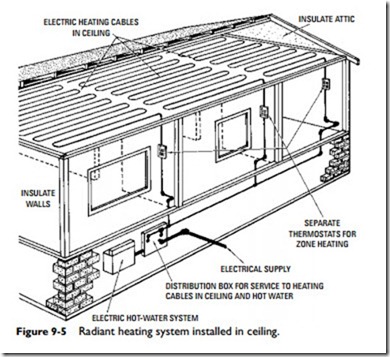Radiant Heating Systems
Any electrical conductor that offers resistance to the flow of electricity generates a certain amount of heat; the amount of heat generated is in direct proportion to the degree of resistance. This method of generating heat is employed in radiant heating systems.
The conductor commonly used in radiant heating systems is an electric heating cable embedded in the floors, walls, or ceilings (Figures 9-5 and 9-6). The cables may be installed at the site (as is often the case with new construction), or they may be obtained in the form of prewired, factory-assembled, panel-type units. The heat generated by the cables is transferred to the occupants and surfaces in the room by low-intensity radiation.
Site-installed heating cables or prewired and assembled panel units are used in the following radiant heating systems:
1. Radiant ceiling panel systems
2. Radiant wall panel systems
3. Radiant floor panel systems
Radiant ceiling heating systems are by far the most commonly used type. The other two have certain disadvantages inherent in their construction. All three radiant heating systems are described in greater detail in Chapter 1 of Volume 3, “Radiant Heating.”
The electric heating cables are activated and controlled by wall- mounted, low-voltage or line thermostats. Cooling can be accomplished only by adding a separate and independent system.
